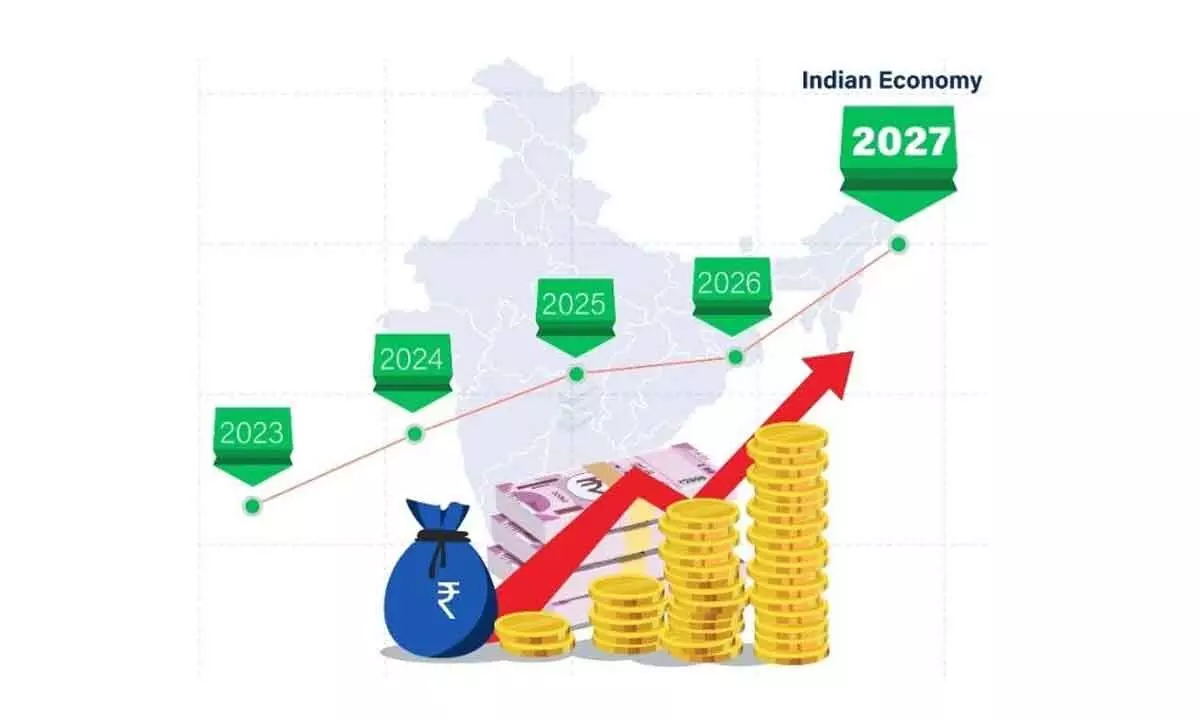Indian economy to pick up at 7% by fiscal 2027
Manufacturing and services sectors will continue to support the economy: S&P
image for illustrative purpose

The UN's primary economic report paints a gloomy economic forecast for the near future. Challenges such as consistently high interest rates, heightened conflict escalation, slow international trade, and a rising number of climate disasters present significant hurdles to global growth
India is likely to have grown 7% for the 2023/24 fiscal year ending in March according to GDP estimates.
The advance estimates of GDP, released by the National Statistical Office, go under six revisions over time. An increased estimate of annual gross domestic product is widely expected after the Reserve Bank of India (RBI) revised its own growth forecast to 7% for the current fiscal year, from an earlier estimate of 6.5%.
The Indian economy grew faster than expected 7.6% year-on-year in the September quarter, after growing 7.8% in the previous quarter, prompting many private economists to upwardly revise their yearly estimates.
Among others, S&P Global Ratings expects India will remain the fastest-growing major economy for the next three years, setting to become the world's third-largest economy by 2030.
S&P expects India, currently the fifth-largest economy, to grow at 6.4% this fiscal and estimates growth will pick up to 7% by fiscal 2027.
While manufacturing and services sectors will continue to support the economy, erratic rainfall patterns will likely dampen agricultural output, it said.
"The risk of a surge in inflation in the coming months cannot be ruled out, however, as potential increases in commodity prices and the adverse impact of climate events on food prices could disrupt the pace of disinflation," the report said.
In India, labour market indicators improved over the year, with labour force participation increasing in August to its highest rate since the onset of the pandemic, the report said, citing the Reserve Bank of India.
The unemployment rate averaged 7.1 per cent in September, the lowest value in a year, with unemployment in rural areas falling despite weaker monsoon rains. Youth unemployment rates declined significantly during the first quarter of 2023 to the lowest value since the pandemic, it said.
The United Nations' World Economic Situation and Prospects (WESP) 2024 report, released on January 4, forecasts a 5.2% growth in gross domestic product (GDP) in South Asia for 2024. This growth is attributed to a strong expansion in India, maintaining its position as the world's fastest-growing large economy. “Growth in India is projected to reach 6.2% in 2024, slightly lower than the 6.3% estimate for 2023, amid robust domestic demand and strong growth in the manufacturing and services sectors,” the report said.
India's GDP is anticipated to grow by 6.6% in 2025, with the report highlighting the projection of "strong" economic growth at 6.2% for the current year. This growth is primarily attributed to resilient private consumption and robust public investment.
“While manufacturing and services sectors will continue to support the economy, erratic rainfall patterns will likely dampen agricultural output,” it said.
Consumer price inflation in India is forecast to slow down from 5.7% in 2023 to 4.5% in 2024, remaining within the Central Bank's medium-term inflation target range of two to six percent.
“The risk of a surge in inflation in the coming months cannot be ruled out, however, as potential increases in commodity prices and the adverse impact of climate events on food prices could disrupt the pace of disinflation,” the report said.
Despite improvements in some countries, the labor market situation in South Asia remained fragile in 2023.
“In India, labour market indicators improved over the year, with labour force participation increasing in August to its highest rate since the onset of the pandemic,” the report said, citing the Reserve Bank of India.
“The unemployment rate averaged 7.1% in September, the lowest value in a year, with unemployment in rural areas falling despite weaker monsoon rains. Youth unemployment rates declined significantly during the first quarter of 2023 to the lowest value since the pandemic,” it said.
“This latest forecast comes on the heels of global economic performance exceeding expectations in 2023. However, last year’s stronger-than-expected GDP growth masked short-term risks and structural vulnerabilities,” it said. The UN's primary economic report paints a gloomy economic forecast for the near future. Challenges such as consistently high interest rates, heightened conflict escalation, slow international trade, and a rising number of climate disasters present significant hurdles to global growth.
“2024 must be the year when we break out of this quagmire. By unlocking big, bold investments we can drive sustainable development and climate action, and put the global economy on a stronger growth path for all,” UN Secretary-General Antonio Guterres said.

